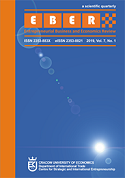Intra-industry trade and implications of the European Union-Japan Economic Partnership Agreement from the perspective of the automotive industry
Intra-industry trade and implications of the European Union-Japan Economic Partnership Agreement from the perspective of the automotive industry
Author(s): Bogusława Drelich-Skulska, Sebastian BobowskiSubject(s): Supranational / Global Economy, International relations/trade
Published by: Uniwersytet Ekonomiczny w Krakowie
Keywords: EU-Japan EPA; intra-industry trade; automotive industry;
Summary/Abstract: Objective: The objective of the article is to identify patterns of intra-industry trade between the European Union (EU) and Japan in the automotive industry and to provide implications of key provisions of the EU-Japan Economic Partnership Agreement (EPA) for this sector. Research Design & Methods: We conducted an analysis of intra-industry trade disaggregated into 65 six-digit HS tariff codes using the UN Comtrade database. Findings: Our results confirm the potential of intra-industry trade in the automotive industry, reflected by its increasing volume, as well as the role of high-quality vertical intra-industry trade (VIIT). From the perspective of the EU, it is important to stress the improvement of the trade balance with Japan in the automotive industry and the rising position of Japan as an EU trade partner. Trade liberalisation under the EU-Japan EPA, including both tariff and non-tariff measures, may contribute to the further expansion of the EU-Japan bilateral trade in the automotive industry. However, mid- and long-term trends in intra-industry flows, including their horizontal and vertical patterns, depend on the industry’s competitiveness and corresponding quality and cost differences. Implications & Recommendations: The authors studied regulatory implications of the EU-Japan EPA for the automotive industry, including sectoral Annexes and Appendix of the EPA. The authors pointed to theoretical and empirical objections in the research process, related mostly to the degree of the disaggregation of statistics and the choice of trade nomenclature. The necessity of further research was stressed at the disaggregated country-country level to eliminate distortions of data on the IIT patterns and verify the relevance of countryand industry-specific determinants of trade, including FDI. Detailed studies of implications of the EU-Japan EPA should be undertaken in one year, when regulatory frameworks of the EU-UK and UK-Japan trade relations will be finally agreed upon and formalised. Contribution & Value Added: The automotive industry is an important contributor to employment, GDP and R&D expenditures for both the EU and Japan. Therefore, trends in intra-industry trade and the EPA’s implications in this sector deserve attention and in-depth analysis. To the best of our knowledge, there has been no such industry-level analysis of the EU-Japan EPA so far. The authors considered consequences of Brexit for the automotive industry, including various scenarios of the future EU-UK and Japan-UK trade relations.
Journal: Entrepreneurial Business and Economics Review
- Issue Year: 9/2021
- Issue No: 2
- Page Range: 183-206
- Page Count: 24
- Language: English

